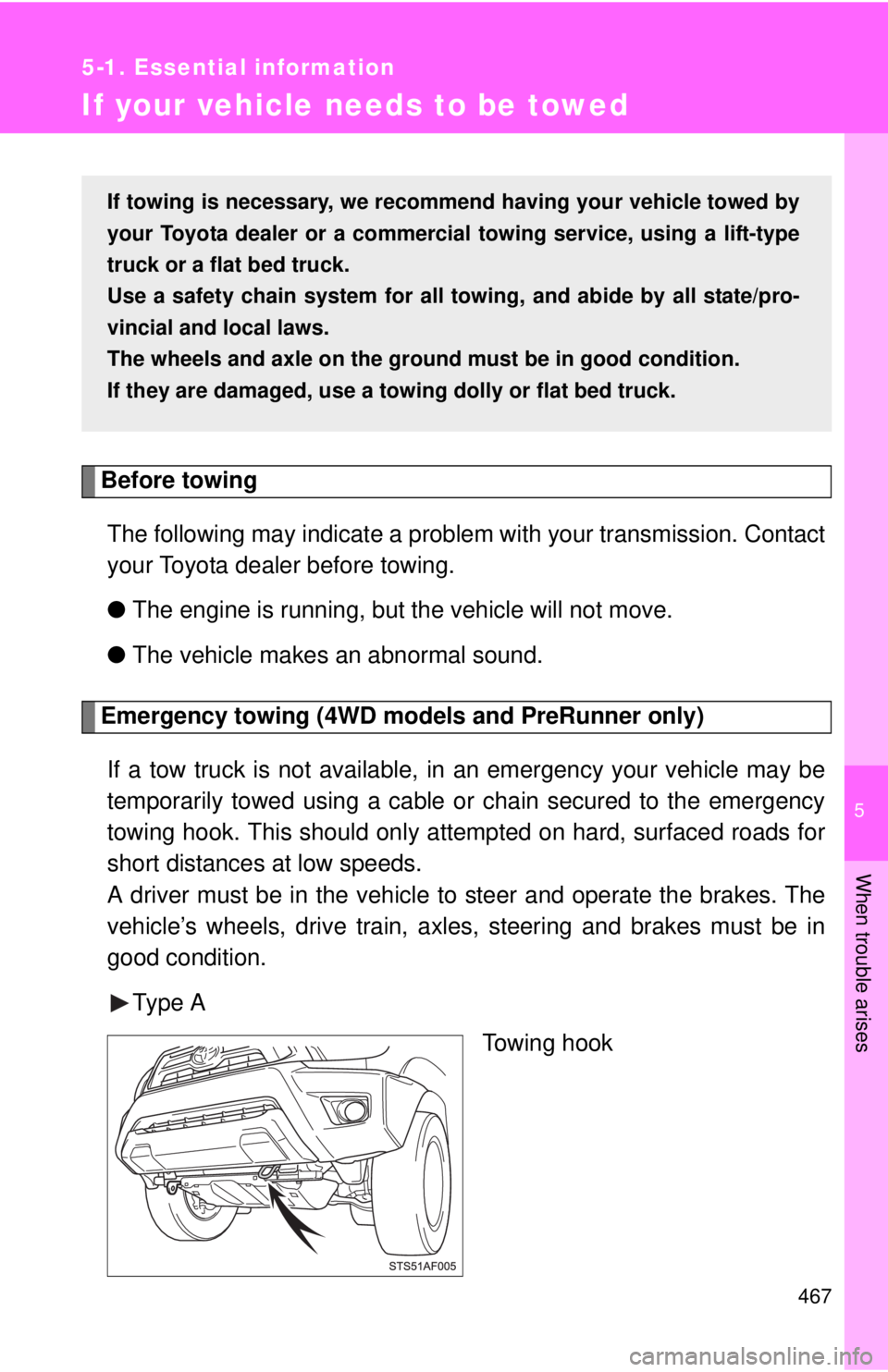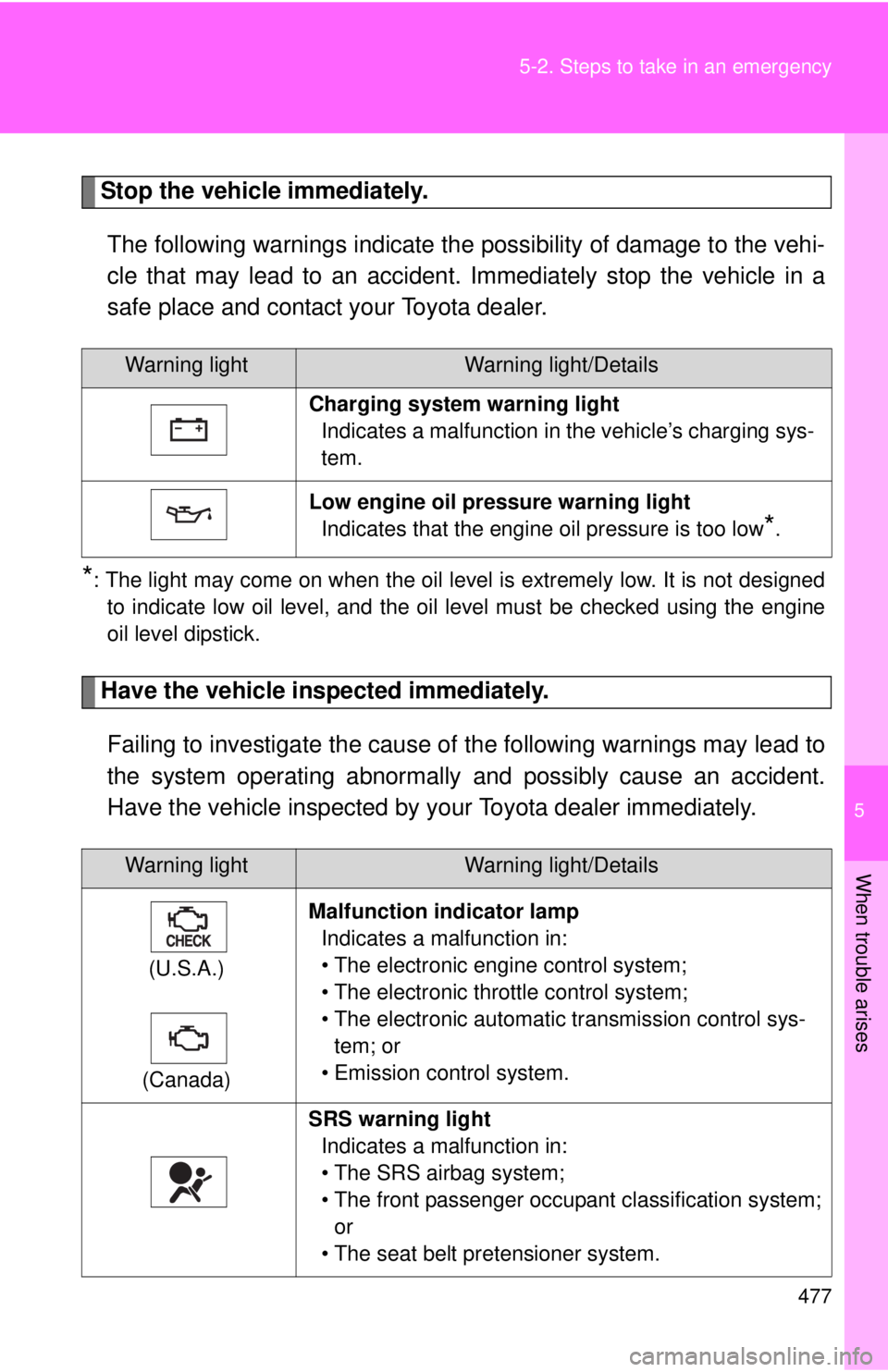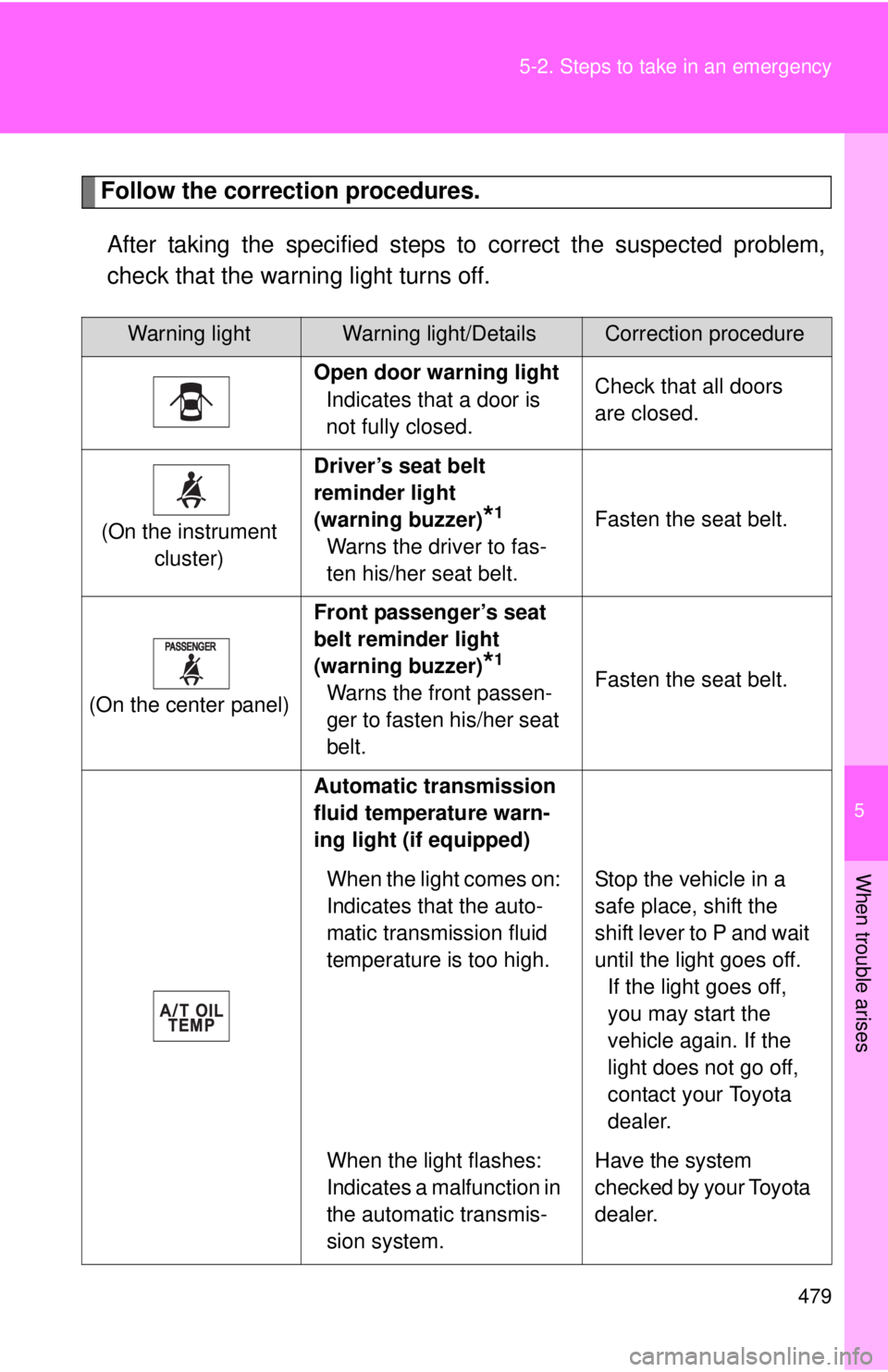Page 397 of 590
397
4-2. Maintenance
4
Maintenance and care
Vehicle interior
ItemsCheck points
Accelerator pedal • Moves smoothly (without uneven
pedal effort or catching)?
Automatic transmission “Park”
mechanism • Can the vehicle be held securely
on an incline with the shift lever in
P?
Brake pedal • Moves smoothly?
• Does it have appropriate clear-
ance and correct amount of free
play?
Brakes • Not pull to one side when
applied?
• Loss of brake effectiveness?
• Spongy feeling brake pedal?
• Pedal almost touches floor?
Clutch pedal • Moves smoothly?
• Does it have correct amount of
free play?
Head restraints • Move smoothly and lock
securely?
Indicators/buzzers • Function properly?
Lights • Do all the lights come on?
• Headlights aimed correctly?
Parking brake • Moves smoothly?
• Can hold the vehicle securely on
an incline?
Seat belts • Does the seat belt system oper-
ate smoothly?
• Are the belts undamaged?
Seats • Do the seat controls operate
properly?
Page 401 of 590
401
4-3. Do-it-yourself maintenance
4
Maintenance and care
ItemsParts and tools
Light bulbs
(P. 454)
• Bulb with same number and watt-
age rating as original
• Phillips-head screwdriver
• Conventional wrench
Power steering fluid level (P. 416)• Automatic transmission fluid
DEXRON® II or III
• Rag or paper towel
Radiator and condenser (P. 414)
Tire inflation pressure ( P. 431)• Tire pressure gauge
• Compressed air source
Washer fluid (P. 420)
• Washer fluid containing antifreeze
(for winter use)
• Water
Page 417 of 590
417
4-3. Do-it-yourself maintenance
4
Maintenance and care
■
Checking the fluid level
Make sure to check the fluid type and prepare the necessary items.
Clean all dirt off the reservoir.
Remove the cap by turning it counterclockwise.
Wipe the dipstick clean.
Reinstall and remove the reservoir cap again.
Check the fluid level.
Fluid type Automatic transmission fluid DEXRON® II or III
Items Rag or paper towel
CAUTION
■Checking the fluid level
Take care, as the reservoir may be hot.
NOTICE
■When adding fluid
Avoid overfilling, or the power steering may be damaged.
■ After replacing the reservoir cap
Check the steering box case, vane pump and hose connections for leaks or
damage.
Page 465 of 590
When trouble arises5
465
5-1. Essential informationEmergency flashers ......... 466
If your vehicle needs to be towed ........................ 467
If you think something is wrong ............................. 474
Fuel pump shut off system ........................... 475 5-2. Steps to take in
an emergency
If a warning light turns on or a warning buzzer
sounds... ........................ 476
If you have a flat tire......... 486
If the engine will not start ................................ 501
If the shift lever cannot be shifted from P (vehicles
with an automatic
transmission) ................. 502
If you lose your keys ........ 503
If the vehicle battery is discharged ..................... 504
If your vehicle overheats ....................... 508
If the vehicle becomes stuck .............................. 511
If your vehicle has to be stopped in
an emergency ................ 513
Page 467 of 590

5
When trouble arises
467
5-1. Essential information
If your vehicle needs to be towed
Before towingThe following may indicate a problem with your transmission. Contact
your Toyota dealer before towing.
● The engine is running, but the vehicle will not move.
● The vehicle makes an abnormal sound.
Emergency towing (4WD models and PreRunner only)
If a tow truck is not available, in an emergency your vehicle may be
temporarily towed using a cable or chain secured to the emergency
towing hook. This should only attempted on hard, surfaced roads for
short distances at low speeds.
A driver must be in the vehicle to steer and operate the brakes. The
vehicle’s wheels, drive train, axles, steering and brakes must be in
good condition.
Type A Towing hook
If towing is necessary, we recommend having your vehicle towed by
your Toyota dealer or a commerci al towing service, using a lift-type
truck or a flat bed truck.
Use a safety chain system for all to wing, and abide by all state/pro-
vincial and local laws.
The wheels and axle on the groun d must be in good condition.
If they are damaged, use a towing dolly or flat bed truck.
Page 470 of 590
470 5-1. Essential information
Towing with a wheel lift-type truck from the frontVehicles with an automatic trans-
mission: Use a towing dolly
under the rear wheels.
2WD models with a manual
transmission: We recommend to
use a towing dolly under the rear
wheels.
When not using a towing dolly,
release the parking brake and
shift the shift lever to N.
4WD models with a manual
transmission: We recommend to
use a towing dolly under the rear
wheels.
When not using a towing dolly,
release the parking brake, shift
the shift lever to N and put the
front-wheel drive control switch in
H2.
NOTICE
■To prevent causing serious damage to the transmission (vehicles with
an automatic transmission)
Never tow this vehicle wheels on the ground.
Page 477 of 590

5
When trouble arises
477
5-2. Steps to take in an emergency
Stop the vehicle immediately.
The following warnings indicate the possibility of damage to the vehi-
cle that may lead to an accident. Immediately stop the vehicle in a
safe place and contact your Toyota dealer.
*: The light may come on when the oil level is extremely low. It is not designed to indicate low oil level, and the oil level must be checked using the engine
oil level dipstick.
Have the vehicle inspected immediately.
Failing to investigate the cause of the following warnings may lead to
the system operating abnormally and possibly cause an accident.
Have the vehicle inspected by your Toyota dealer immediately.
Warning lightWarning light/Details
Charging system warning light Indicates a malfunction in the vehicle’s charging sys-
tem.
Low engine oil pressure warning light Indicates that the engine oil pressure is too low
*.
Warning lightWarning light/Details
(U.S.A.)
(Canada) Malfunction indicator lamp
Indicates a malfunction in:
• The electronic engine control system;
• The electronic throttle control system;
• The electronic automatic transmission control sys-tem; or
• Emission control system.
SRS warning light Indicates a malfunction in:
• The SRS airbag system;
• The front passenger occupant classification system; or
• The seat belt pretensioner system.
Page 479 of 590

5
When trouble arises
479
5-2. Steps to take in an emergency
Follow the correction procedures.
After taking the specified steps to correct the suspected problem,
check that the warning light turns off.
Warning lightWarning light/DetailsCorrection procedure
Open door warning light Indicates that a door is
not fully closed. Check that all doors
are closed.
(On the instrument cluster) Driver’s seat belt
reminder light
(warning buzzer)
*1
Warns the driver to fas-
ten his/her seat belt.
Fasten the seat belt.
(On the center panel) Front passenger’s seat
belt reminder light
(warning buzzer)
*1
Warns the front passen-
ger to fasten his/her seat
belt.
Fasten the seat belt.
Automatic transmission
fluid temperature warn-
ing light (if equipped) When the light comes on:
Indicates that the auto-
matic transmission fluid
temperature is too high. Stop the vehicle in a
safe place, shift the
shift lever to P and wait
until the light goes off.
If the light goes off,
you may start the
vehicle again. If the
light does not go off,
contact your Toyota
dealer.
When the light flashes:
Indicates a malfunction in
the automatic transmis-
sion system.
Have the system
checked by your Toyota
dealer.